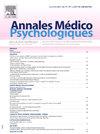儿童期和成年期多动症诊断
IF 0.5
4区 医学
Q4 PSYCHIATRY
引用次数: 0
摘要
注意缺陷多动障碍(ADHD)属于神经发育障碍(ndd)家族,与自闭症谱系障碍、特殊学习障碍、发育协调障碍和图雷特吉尔综合征等疾病属于同一类别。ndd通常与其他疾病共存,并与各种精神或非精神疾病共存,这可能会模糊原发疾病的诊断,特别是在考虑患者的年龄和性别时。精神合并症既包括内化障碍,如焦虑和抑郁,也包括外化障碍,包括对立违抗障碍和行为障碍。虽然白日梦和情绪失调在儿童和成人多动症患者中经常观察到,但它们并不构成该疾病的诊断标准,而是共病特征。这些疾病的同时存在可以产生复杂的临床图像,需要细致入微和谨慎的管理策略。精神病学领域之外的合并症包括各种睡眠障碍(昼夜节律紊乱、磨牙症、遗尿症、不宁腿综合征等)、神经系统疾病,如癫痫和偏头痛,以及特应性疾病、炎症和自身免疫性疾病,以及某些遗传综合征,但不仅如此。在6岁以下的儿童中——认识到多动症可以在这个早期阶段就被诊断出来——各种疾病的表现经常交织在一起,最终形成一个总体的表型。随着儿童年龄的增长,这些症状群往往变得更加明显和个性化。与男性相比,被诊断患有多动症的女性不太可能表现出明显的多动和冲动的迹象。他们可能会采取代偿行为来掩盖或减轻症状的表现。此外,与外化障碍相比,女性更有可能出现共病的内化障碍,如焦虑和抑郁,这可能导致这一人群对ADHD的诊断不足。ADHD的患病率不容忽视,估计有2%的学龄前儿童、4%的学龄儿童、3%的成年人和1%的60岁以上人口受到影响,仅在法国就有200多万人受到影响。诊断标准完全是临床标准,在诸如美国精神病学协会的《诊断和统计手册》和世界卫生组织的《国际疾病分类》等国际分类中,二十多年来一直保持不变。缺乏一种可靠的生物标志物来证实或反驳诊断,强调了ADHD识别的挑战。诊断延误或疏忽的后果是深远的,可能会给受影响的儿童及其家庭带来可怕的后果,包括青少年和成年人自杀行为的风险增加,法律纠纷甚至监禁的可能性增加。这篇综述文章描述了ADHD筛查和诊断的系统方法,包括特征症状的识别及其影响,与其他诊断的区分,以及可能需要的辅助评估。这些成分对于告知治疗策略、患者管理、药理干预及其不良反应的监督至关重要。我们为临床应用提供了评估量表和半结构化访谈的纲要,使从业者能够选择最适合他们的专业知识和手边的诊断或评估目标的工具。总之,ADHD的诊断是建立在由精通典型儿童发育和神经发育障碍的医生进行的系统的临床评估的基础上的,避免依赖补充的生物学、电生理学、神经心理学测试或神经影像学。本文章由计算机程序翻译,如有差异,请以英文原文为准。
Le diagnostic du TDAH dans l’enfance et à l’âge adulte
Attention Deficit Hyperactivity Disorder (ADHD) is classified within the family of neurodevelopmental disorders (NDDs), sharing the category with conditions such as Autism Spectrum Disorder, Specific Learning Disorders, Developmental Coordination Disorder, and Gilles de la Tourette Syndrome, among others. NDDs often coexist with one another and with various psychiatric or non-psychiatric conditions, which can obscure the primary disorder's diagnosis, especially when considering the patient's age and gender. Psychiatric comorbidities encompass both internalizing disorders, such as anxiety and depression, and externalizing disorders, including oppositional defiant disorder and conduct disorder. While daydreaming and emotional dysregulation are frequently observed in children and adults with ADHD, they do not constitute diagnostic criteria for the disorder but rather comorbid features. The concomitant presence of these disorders can create complex clinical pictures, necessitating nuanced and careful management strategies. Comorbidities extending beyond psychiatric realms include various sleep disorders (disruptions in circadian rhythms, bruxism, enuresis, restless legs syndrome, among others), neurological conditions such as epilepsy and migraine, as well as atopic conditions, inflammatory and autoimmune diseases, and certain genetic syndromes, but not only. In children younger than six years old – recognizing that ADHD can be considered for diagnosis at this early stage – the manifestations of various disorders frequently intertwine, culminating in an overarching phenotype. As children age, these symptom clusters tend to become more distinct and individualized. In contrast to males, females diagnosed with ADHD are less likely to exhibit conspicuous signs of hyperactivity and impulsivity. They might adopt compensatory behaviors to obscure or diminish the manifestation of their symptoms. Furthermore, females have an increased likelihood of developing comorbid internalizing disorders, such as anxiety and depression, as opposed to externalizing disorders, which may contribute to the underdiagnosis of ADHD in this population. The prevalence of ADHD is non-negligible, affecting an estimated 2% of pre-schoolers, 4% of school-aged children, 3% of adults, and 1% of the population aged over 60, implicating more than two million individuals in France alone. Diagnostic criteria are exclusively clinical and have remained unchanged for over two decades in international classifications such as the Diagnostic and Statistical Manual of the American Psychiatric Association and the International Classification of Diseases by the World Health Organization. The absence of a reliable biomarker to confirm or refute the diagnosis underscores the challenges in ADHD identification. The ramifications of diagnostic delay or oversight are profound, potentially leading to dire consequences for affected children and their families, including elevated risks of suicidal behavior in adolescents and adults and increased potential for legal entanglements, even incarceration. This review article delineates the systematic approach to ADHD screening and diagnosis, including the identification of hallmark symptoms and their impacts, differentiation from other diagnoses, and the contemplation of ancillary assessments that may be warranted. These components are pivotal for informing therapeutic strategies, patient management, and the oversight of pharmacological interventions and their adverse effects. We furnish a compendium of evaluative scales and semi-structured interviews for clinical utility, enabling practitioners to elect tools best suited to their expertise and the diagnostic or evaluative objectives at hand. In sum, the diagnosis of ADHD is predicated on a methodical clinical assessment executed by a practitioner well versed in typical child development and neurodevelopmental disorders, eschewing reliance on supplemental biological, electrophysiological, neuropsychological testing, or neuroimaging.
求助全文
通过发布文献求助,成功后即可免费获取论文全文。
去求助
来源期刊

Annales medico-psychologiques
医学-精神病学
CiteScore
1.30
自引率
33.30%
发文量
196
审稿时长
4-8 weeks
期刊介绍:
The Annales Médico-Psychologiques is a peer-reviewed medical journal covering the field of psychiatry. Articles are published in French or in English. The journal was established in 1843 and is published by Elsevier on behalf of the Société Médico-Psychologique.
The journal publishes 10 times a year original articles covering biological, genetic, psychological, forensic and cultural issues relevant to the diagnosis and treatment of mental illness, as well as peer reviewed articles that have been presented and discussed during meetings of the Société Médico-Psychologique.To report on the major currents of thought of contemporary psychiatry, and to publish clinical and biological research of international standard, these are the aims of the Annales Médico-Psychologiques.
 求助内容:
求助内容: 应助结果提醒方式:
应助结果提醒方式:


